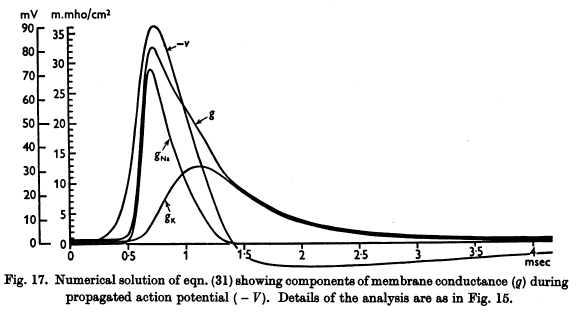I would like to ask if the amplitude of action potential in animals(for example zebra finch or other bird) differs from the amplitude of action potential in humans which is approximately 70mV.
-
$\begingroup$ I would like to note that the 70mV you're referring to, is actually -70mV, and represents the resting potential of an adult, vertebrate neuron. When an action potential occurs, the depolarization amplitude is not 70mV, but instead right around 100mV. $\endgroup$– user22020Commented Aug 20, 2017 at 23:58
1 Answer
Does the amplitude of action potential in animals differ from the amplitude of action potential in humans?
Surprisingly, they don't!
The current model that's used to describe biophysical neurons is the Hodgkin-Huxley model, and one of its fundamental assumptions is that, action potentials (APs) are electrical events consisting of a large transient change in membrane polarization (typically around 100 mV). (source)
The reason for this can be seen when quantifying the absolute value of peak conductance during an AP, specifically when considering the average membrane resistance with respect to peak conductance. The following graph is from the original publication by Huxley & Hodgkin, just here, and it illustrates this principle.
This model applies to virtually all excitable cells, and therefore, AP amplitude values aren't specific to the organism. Consider the following table which lists AP measurements amongst various animals, and pay notice to the values in the highlighted column. As can be seen, amplitude values remain fairly consistent across all animal types, hovering right around 100mV. (source)
And then, regarding humans, just as you stated, the resting potential of a neuron is ~ -70mV. When excited, the membrane potential rises to ~ +30mV.
Most cells in the body make use of charged particles, ions, to build up a charge across the cell membrane. ... The exact value measured for the resting membrane potential varies between cells, but -70 mV is most commonly used as this value. ... The change in the membrane voltage from -70 mV at rest to +30 mV at the end of depolarization is a 100-mV change.
(source)
If you're well versed in math, you can directly compute the ~100mV change in membrane potential using the Goldman/Hodgkin/Katz equation, given that inter & extra cellular ion concentrations are known.
-
3



